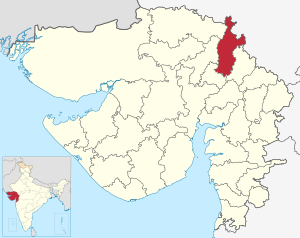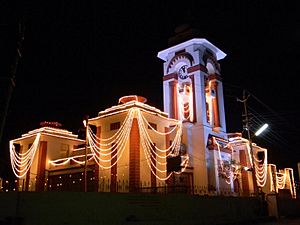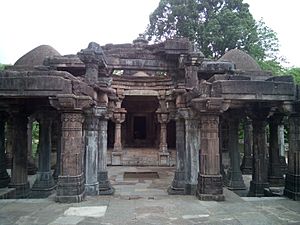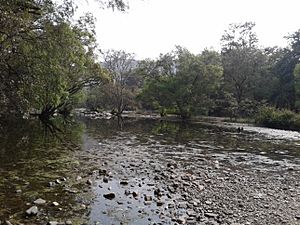Sabarkantha district facts for kids
Quick facts for kids
Sabarkantha district
|
|
|---|---|
|
District of Gujarat
|
|
|
Clockwise from top-left: Roda Temples, Rajchandra Vihara, Idar, Brahma Temple, Khedbrahma, Abhapur temples in Polo Forest, Tower Chowk, Himatnagar
|
|

Location of district in Gujarat
|
|
| Country | |
| State | Gujarat |
| Headquarters | Himatnagar |
| Area | |
| • Total | 5,390 km2 (2,080 sq mi) |
| Population
(2011)
|
|
| • Total | 1,388,671 |
| • Density | 257.64/km2 (667.3/sq mi) |
| Languages | |
| • Official | Gujarati, Hindi |
| Time zone | UTC+5:30 (IST) |
| ISO 3166 code | GJ-IN |
| Vehicle registration | GJ-9 |
Sabarkantha district is one of the 33 districts in the state of Gujarat, India. It is located in the northeastern part of the state. The main administrative office for the district is in Himatnagar.
Contents
Quick Facts About Sabarkantha
Here are some interesting facts about the Sabarkantha district:
- Location: It is located between 23.030 and 24.30 degrees North latitude and 72.43 and 73.39 degrees East longitude.
- Climate: Winters can be cool, with temperatures as low as 9°C. Summers can be very hot, reaching up to 49°C. The climate is generally mild.
- Soil Types: The district has different types of soil, including white, black, rocky, sandy, and hilly soil.
- Rivers: Important rivers flowing through the district include Sabarmati, Khari, Meshvo, Hathmati, Harnao, Vatrak, and Mazam River.
- Main Crops: Farmers here grow crops like paddy (rice), millet, cotton, wheat, sorghum, tobacco, groundnut (peanuts), castor, and various vegetables such as tomatoes and cauliflower.
- Villages and Towns: There are 1,389 villages in total. The district has 714 Gram Panchayats (village councils) and 325 Group Gram Panchayats. There are also 6 municipalities (towns).
- Highways: National Highway No. 48 passes through this district, connecting different areas.
Geography of Sabarkantha
Sabarkantha District shares its borders with the state of Rajasthan to the north and northeast. To the west, it is next to Banaskantha district and Mehsana district. Gandhinagar district is to its south, and Aravalli district is to the southeast.
The district covers an area of 5,390 square kilometers. For every 1,000 men, there are about 950 women. The literacy rate, which is the percentage of people who can read and write, is 76.6% in the district.
History of Sabarkantha
Ancient Times
Long ago, during the rule of the Western Satraps, this area was known as Shwabhra. Around 150 A.D., Satrap Rudradama ruled this region. This is mentioned in ancient stone carvings found in Junagadh. The river here was originally called Shwabhravati. Today, it is known as the Sabarmati River. The region is also mentioned in old texts related to the famous grammarian Pāṇini.
British Rule and Formation
During the time of the British Raj, Vijaynagar in Sabarkantha district was the capital of Vijaynagar State. This was one of the many small states in the Mahi Kantha Agency.
The Sabarkantha district we know today was created in 1949. It was formed by combining 29 small princely states and some parts of the Ahmedabad district, which was under British rule. Later, in 1960, when the old Bombay state was divided, Sabarkantha became part of the newly formed state of Gujarat.
Economy of Sabarkantha
In 2006, the Ministry of Panchayati Raj identified Sabarkantha as one of the 250 most economically challenged districts in India. It is one of six districts in Gujarat that receives special funds. These funds come from the Backward Regions Grant Fund Programme (BRGF). This program helps districts that need extra support for development.
Administrative Divisions
Sabarkantha district is divided into 8 smaller administrative areas called talukas:
- Himatnagar
- Idar
- Prantij
- Talod
- Khedbrahma
- Poshina
- Vadali
- Vijaynagar
Population and People
Population Details
According to the 2011 census, Sabarkantha district had a population of 2,428,589 people. This number is similar to the population of a country like Kuwait. This makes it the 183rd most populated district out of 640 in India.
The district has about 328 people living per square kilometer. Between 2001 and 2011, the population grew by 16.56%. For every 1,000 men, there were 950 women. The literacy rate, which is how many people can read and write, was 76.6%.
The remaining part of the district had a population of 1,388,671. About 17.08% of these people lived in urban areas (towns and cities). In this area, there were 951 women for every 1,000 men. About 9.03% of the population belonged to Scheduled Castes, and 23.64% belonged to Scheduled Tribes.
Religions in Sabarkantha
| Religions in Sabarkantha district (2011) | ||||
|---|---|---|---|---|
| Religion | Percent | |||
| Hinduism | 92.55% | |||
| Islam | 6.48% | |||
| Jainism | 0.72% | |||
| Other or not stated | 0.25% | |||
Most people in Sabarkantha district follow Hinduism. In 2011, there were 1,285,218 Hindus. There were also 90,027 Muslims and 9,990 Jains living in the district.
Languages Spoken
According to the 2011 Census of India, most people in the district speak Gujarati as their first language. About 97.85% of the population speaks Gujarati. Another 1.63% of the people speak Hindi.
Important Forts
Idario Gadh: An Ancient Fort
Idario Gadh is an ancient fort also known as 'Ilva Durga'. It is mentioned in the ancient Indian epic Mahabharata. This fort is a great example of a hill fort that is naturally protected. It is located at the southern edge of the Aravalli mountain range.
At the bottom of the hill, you can find the remains of an old palace. This palace shows beautiful stone architecture with finely carved balconies. To enter Idar town, you pass through a three-story clock tower that also serves as an entrance gate. It has a large arch and a round dome at the top. A colorful market road leads to this tower and ends at the base of the Idar fort.
Heritage Sites to Visit
Vijay Villas Vijaynagar
Vijay Villas Vijaynagar is a beautiful place nestled at the foot of the Aravalli mountain ranges. It is located on the edge of one of the few remaining dense forests in Gujarat. This area is in the Sabarkantha district, right on the border of Gujarat and Rajasthan. It is a wonderful spot for people who love nature and wildlife.
Darbargadh in Poshina
About 18 kilometers from Ambaji in Sabarkantha district is the village of Poshina. This village shows the simple beauty of traditional village life. It is home to many colorful tribal communities, including the Garasias, Bhils, and the pastoral Rabaris.
Poshina has a special tribal shrine. Here, you can see thousands of terracotta (clay) horses arranged in rows. These horses are offerings to the local goddess. Nearby villages also have similar horses, made to show respect to her. Visiting the homes of the potters who make these horses gives you a great look into tribal culture.
In Poshina, you will find the Darbargadh Poshina. This used to be a palace but is now a welcoming heritage hotel. It has large gateways, a huge dome, many pillars and arches, a pleasant courtyard, gardens, and terraces. The hotel is owned by the descendants of the Chalukyas, who ruled much of Gujarat in the 12th century. You can also see old Jain sandstone temples of Parshvanath and Neminath, and an old Shiva temple here.
Sabarkantha district also hosts the famous Chitra Vichitra Fair. This fair takes place in Gunbhakhari village, a couple of weeks after the Holi festival.
Polo Forest
Polo Forest covers an area of 400 square kilometers. It is located near Abhapur village in the Vijaynagar taluka of Gujarat. Beautiful hills surround Polo Forest. The Harnav River flows through the forest. Ancient Shiv temples, Jain temples, and other historical sites are located nearby. Every year, the Gujarat government organizes the Polo festival. This festival includes adventure activities, cycling, and camping events.
Famous People from Sabarkantha
- Umashankar Joshi (1911–1988): A famous writer and scholar, born in Bamna (now in Aravalli district).
- Rashid Patel: An Indian cricketer.
- Zohraben Chavda (1923–1997): A social reformer who followed Mahatma Gandhi's ideas. She was also a member of the 3rd Loksabha from Banaskantha.
- Manoj Joshi: A well-known actor and comedian, born in Himmatnagar.
- Praful Khoda Patel: A politician and administrator of Diu, Daman, and Dadra Nagar Haveli.
See also
 In Spanish: Distrito de Sabarkantha para niños
In Spanish: Distrito de Sabarkantha para niños
- Punsari
- Harsol










